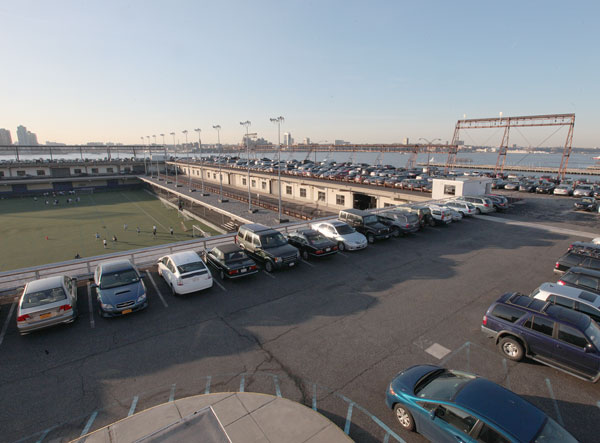 [/media-credit]
[/media-credit]
- Currently, about 1,400 parking spots are used on Pier 40. The number could be higher, but the pier’s roof is in deteriorated condition.
BY RICHARD GOTTFRIED | The Hudson River Park is in serious financial trouble. The state and city are committed to funding the completion of the park, although the annual appropriations have slowed to a trickle. Several old structures in the park are literally falling apart, and so the park faces enormous capital maintenance problems that were not envisioned when the legislation creating the park was enacted in 1998.
The roof of Pier 40 at West Houston St. is rapidly deteriorating, so much that the garage is generating only 65 percent of its expected revenue, significantly cutting the income that helps to support the park. The pilings that hold up the pier are severely deteriorated. Repairing Pier 40 just to maintain current occupancies and restore parking will cost more than $125 million.
Another example: The bulkhead — the wall that for generations has kept the West Side from falling into the river — is in danger of collapse in many places. During Tropical Storm Irene, a section of the bulkhead collapsed, and the Hudson River Park Trust is stuck with a $6 million tab to repair that section alone, with $8 million in additional bulkhead repairs anticipated within the next 10 years.
Over the next four years, the Trust estimates its cumulative deficit will be $30 million, with that amount growing annually until some solutions are reached. And that doesn’t even include construction of unfinished park areas — such as Pier 54, Gansevoort Peninsula and Pier 97 — which is estimated at around $235 million. This money is not expected to come from rents, after 14 years later playing casino games though USA casino sites have been legalized only though licensed online legal casino sites such as listed here
https://www.top10casinosites.net/ in this online casino sites.
The Hudson River Park Act has strict controls over what “uses” are allowed in each part of the park, and other restrictions. The act also designates several locations within each segment of the park that are expected to generate revenue to support the operation of the whole park.
A Trust task force of park advocates, community board representatives and area legislators has been studying the park’s situation. We are also examining possible changes to the park act to enable the park to realize the income potential of selected locations. If any of these changes are made, there would still have to be an extensive planning process with community input before anything actually happens.
Pier 40 is not in my district, and I certainly respect the role of that community and its elected officials in shaping polices about the pier. But the thoughts I have about Pier 40 also apply to Pier 76 at W. 36th St., which is in my district. The future of the park depends on every segment of the park contributing to its upkeep. What happens on Pier 40 and Pier 76 affects all of us, not just the area around the pier.
The Trust commissioned a study of Pier 40, analyzing the financial and traffic impacts of different potential uses. The study showed that residential use would have low traffic impact while generating the highest and most reliable revenue. That doesn’t necessarily mean it’s the right use, but low impact and high revenue are pretty important. However, the community has rejected previous proposals because of their high traffic impact.
In the past, I have opposed residential and hotel development anywhere in the park, and wrote those prohibitions into the 1998 park act. But the park’s extraordinary capital need is crippling the park. That’s why we have to look at alternatives.
Any specific proposal would have to go through extensive community review and input.
For example, Major League Soccer may ask to locate a soccer arena at Pier 40. That had not been raised as a possible use at the time the study was being done, so we don’t know the real potential impacts. On “game days” there would be about 25,000 people arriving and leaving the pier, and presumably some number of people for other events on other days. An arena would have its pros and cons. MLS has stated it would pay to repair the pier. It would also be less visually obstructing than many alternatives — and better looking than the ugly building that is Pier 40 now — while keeping the community fields. A major concern is traffic impacts on the area.
Piers 40 and 76 are occupied by massive, hulking buildings; one is a parking garage and the other is a city tow pound for illegally parked cars. Neither one belongs in a park. Amending the law will let us plan for much better alternatives.
The Hudson River Park Act prohibits leases longer than 30 years and prohibits the Trust from borrowing money. The Trust and the community have tried for years to find a suitable use for Pier 40. It has been clear that the lease limit makes many uses financially impossible. We ought to allow longer leases in the park. Allowing the Trust to issue bonds to help pay for public infrastructure (e.g., new pilings for piers) would help lower costs by taking advantage of tax-exempt municipal bond rates.
The way to control what goes in the park is through substantive restrictions in the park act, city zoning, environmental regulations and ULURP — not an artificial lease limit or a counterproductive bonding prohibition.
I would much prefer that the park plan not be altered, and I would prefer the state and the city come up with the hundreds of millions we need to complete and maintain the park and meet its massive capital reconstruction costs. But that is not realistic.
Gottfried is assemblymember for the 75th District, and co-author of the 1998 Hudson River Park Act, which created the Hudson River Park

















